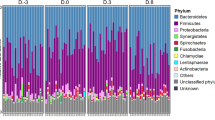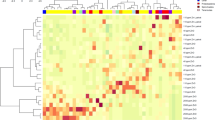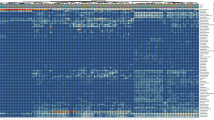Abstract
We investigated the long-term effects of a single intramuscular administration of amoxicillin (15 mg kg−1) 1 day after birth, on piglet intestinal microbiota. Animals received no creep feed before weaning on day 28 of age. For the next 11 days, the piglets received a wheat–barley-based diet. Colon digesta samples were collected on day 39 and subjected to denaturing gradient gel electrophoresis (DGGE) of PCR-amplified 16S rRNA gene fragments. DGGE fingerprint diversity indices differed between the group treated with amoxicillin and the untreated group (0.8±0.19 and 1.03±0.17, respectively, P=0.012). Reamplification and sequencing of two bands present in all samples revealed that a Roseburia faecalis-related population was strongly reduced in relative abundance (98% identity) in the treated group, while an enterobacterial population with 100% identity to Shigella spp., Escherichia coli and Salmonella enterica serovar Typhi was enriched. A band corresponding to Lactobacillus sobrius was present only in the control group. The protective effect of prophylactic antibiotic administration may be outweighed by the long-lasting disturbance of the gut ecosystem.
Similar content being viewed by others
Main
Antibiotics have been used for decades and have allowed control of ancient scourges, but their enormous and uncontrolled use has led to the development of many resistant bacterial strains, causing problems in many hospitals (Leeb, 2004). Antibiotics have been widely used in livestock, to maintain the production and to foster the growth of animals (Nathan, 2004). The European Union has therefore prohibited the use of antibiotics as in-feed growth promoters starting from 2006. However, prophylactic and therapeutic veterinary use has not been affected in any way. It is common in farm animal veterinary practice, especially in the pig sector, to administer antibiotics to prevent infections caused by staphylococci and streptococci. The influence of amoxicillin on human intestinal microbiota has been investigated in several studies. When oral amoxicillin was administered to healthy human volunteers in different doses (250 mg 3 × daily, 500 mg 3 × daily for 7 days or 1000 mg 2 × daily for 14 days), a minor decrease in streptococci and staphylococci within the aerobic intestinal microbiota was observed by selective plating concomitant with reduced numbers of total aerobic bacteria. Overgrowth of enterobacteria, with emergence of resistance against amoxicillin, was also observed (reviewed by Sullivan et al., 2001). Nevertheless, only a limited number of studies has assessed the prolonged impact of antibiotic treatment on gut microbiota. Recently, de la Cochetière et al. (2005) reported a decrease in temporal temperature gradient gel electrophoresis profile similarities after 5-day oral administration of amoxicillin (500 mg 3 × daily), confirming changes in the human fecal bacterial community.
In this study, we applied denaturing gradient gel electrophoresis (DGGE) of 16S rRNA gene fragments that were PCR-amplified from piglet colon content samples to confirm our hypothesis that long-acting antibiotic treatment causes changes in gut microbiota, which persist even after the antibiotic is degraded.
German Landrace piglets from six litters were used in the experiment. Piglets in one treatment group of three litters received intramuscular injection of long-acting amoxicillin (Amoxicillin LA, Ceva, Düsseldorf, Germany) (15 mg kg−1 day−1) on the first day of life; the other piglets from the other treatment group (also three litters) received no antibiotics. Separate litters were taken in the experiment to prevent contact of untreated animals with the antibiotic and its metabolites excreted by treated animals. Sows from each group were kept in separate stands in one room, and untreated and treated groups had no contact with each other. All piglets were kept with their mother until weaning on the 28th day of life without creep feed. After weaning, piglets from each litter were placed in one pen and were offered water and starter diet (Table 1) ad libitum. Mean weights of piglets reached 10.9±1.3 and 10.7±1.1 kg in control and treated group, respectively, at day 39. On day 39, three piglets per pen were randomly selected, killed with intracardial injection of T61 (Intervet, Unterschleissheim, Germany) and dissected, and colonic digesta (from proximal 40–50 cm of the spiral colon) was collected. All procedures involving animal handling and treatment were approved by the Committee for Animal Use and Care of the Agricultural Department of Mecklenburg-Western Pomerania, Germany, according to the German Law for Animal Protection.
We used 16S rRNA gene-targeted PCR-DGGE to assess changes in the diversity of the intestinal microbial community in response to antibiotics administration. This method has been successfully used for several years in the research area of porcine gut ecology (Simpson et al., 1999, 2000; McCracken et al., 2001; Konstantinov et al., 2004) even though it allows estimation of only dominant bacterial populations of the complex intestinal ecosystem owing to DNA extraction sensitivity and PCR-bias (Muyzer and Smalla, 1998).
Genomic DNA from colonic digesta was extracted using a SpinKit for Soil as described in detail by Janczyk et al. (2007). Bacterial 16S rRNA gene fragments were amplified using primers S-D-Bact-0968-a-S-GC and S-D-Bact-1401-a-A-17 (Nübel et al., 1996; Felske et al., 1998) (synthesized by Invitrogen, Paisley, UK) and separated by DGGE on gels with a gradient of 40–65% as described previously (Konstantinov et al., 2004; Janczyk et al., 2007). DGGE images were analyzed applying the AlphaEaseFC software Version 4.0.0 (Alpha Innotech Corporation, San Leonardo, CA, USA).
Figure 1 shows an example of DGGE fingerprint of PCR amplicons from four animals from each group that were randomly selected. In our study, the number of bands was significantly lower in the group treated with amoxicillin than in the untreated group (9.0±4.34 and 14.4±4.39, respectively, P=0.021). In order to compare DGGE profiles with respect to richness (number of bands) and evenness (relative intensity of bands), Shannon diversity indices (H′) were calculated as described (Janczyk et al., 2007). Differences between calculated single values were compared by one-factorial analysis of variance with following post hoc HSD Tukey's test (STATISTICA Version 6.0), and difference of P<0.05 was considered significant. H′ was significantly lower in treated animals as compared to the untreated control group (0.79±0.192 vs 1.03±0.165, respectively, P=0.012). Thus, parenteral antibiotic administration caused a shift in gut bacterial population towards decrease of the diversity and richness of the bacterial community.
(a) DGGE fingerprint of bacterial V6-V8 16S rRNA gene amplicons obtained from colonic samples of piglets 39 days after treatment (1–4, +Ab) or without treatment (5–8, −Ab) with intramuscular amoxicillin. Piglets represented in this image were randomly selected from 18 piglets. Each lane represents one animal. M – marker lanes. Letters a–h mark bands that were successfully reamplified (primers: S-D-Bact-0968-a-S-17 and S-D-Bact-1401-a-A-17 (Nübel et al., 1996; Felske et al., 1998) after excision from the gel and sequenced. (b) Identification of reamplified bands. aRefer to a and bwhen sequences were most closely related to environmental sequences, the closest cultured relative genus is also provided. cIn case of two bands at the same position, number refers to the respective amplicon.
To identify the bacteria corresponding to the most dominant bands in the DGGE profiles, bands of different intensity (Figure 1, letters a–h) were excised with a sterile needle and added to a tube with 80 μl of sterile Millipore water. Reamplification, purification of PCR products and sequencing were conducted as described by Janczyk et al. (2007). Curated sequences were submitted to NCBI BLASTN searches (Altschul et al., 1997) and have been deposited at the GenBank database under accession numbers EF378630–EF378637.
The population corresponding to the most dominating band apparent in all animals in the control group, but to a much lesser extent in animals receiving the antibiotic, was most closely related to Roseburia faecalis, a bacterium belonging to Clostridium cluster XIVa that contains butyrate producing bacteria (Duncan et al., 2002, 2004). Although another band (g), indicative of a butyrate-producing bacterium, was only observed in two of the treated animals, our results overall indicated a strong negative effect of parenteral long-acting amoxicillin on butyrate-producing populations related to Roseburia species. Interestingly, de la Cochetière et al. (2005) observed an appearance of bands matching other Clostridium cluster XIVa bacteria, Clostridium nexile and Ruminococcus torques 3 and 4 days after commencing antibiotic treatment, which were absent before amoxicillin was introduced and after the end of the treatment, on days 30 and 60. This apparent effect of amoxicillin treatment on individual populations of butyrate producing bacteria in colon has not been previously investigated and should be the subject of further studies aiming at its functional implications for the developing gut ecosystem.
An opposite observation could be made for several other bands, including band ‘e’ (Figure 1). The sequencing of this band, which showed higher relative intensity in the antibiotic treatment group, revealed presence of a population most closely related to Shigella spp., different strains of Escherichia coli, including O157:H7 and Salmonella enterica serovar Typhi (100% similarity in all cases).
In pigs, lactobacilli are assumed to play a major role, while bifidobacteria are present to a lesser extent (Loh et al., 2006). The recently isolated Lactobacillus sobrius is an abundant member of the porcine intestinal microbiota (Konstantinov et al., 2006a, 2006b). A band corresponding to L. sobrius was apparent only in the untreated group, albeit as a band of moderate intensity. This suggests that the antibiotic administration caused a reduction in the relative abundance of this species to values below the sensitivity of the method, similar to the R. faecalis-related population.
In the present study, we focused on the influence of intramuscularly administered long-acting amoxicillin on intestinal microbial diversity. We could show that a single intramuscular dose led to significant changes in the lumen gut microbiota of newborn piglets, which persisted well beyond clearance of the antibiotic from the pig. Considering the observed alterations, it is worth reconsidering the prophylactic administration of broad spectrum antibiotics directly after birth.
Accession codes
References
Altschul SF, Madden TL, Schäffer AA, Zhang J, Zhang Z, Miller W et al. (1997). Gapped BLAST and PSI-BLAST: a new generation of protein database search programs. Nucleic Acids Res 25: 3389–3402.
de la Cochetière MF, Durand T, Lepage P, Bourreille A, Galmiche JP, Doré J . (2005). Resilience of the dominant human fecal microbiota upon short-course antibiotic challenge. J Clin Microbiol 43: 5588–5592.
Duncan SH, Hold GI, Barcenilla A, Stewart CS, Flint HI . (2002). Roseburia intestinalis sp. nov., a novel saccharolytic, butyrate-producing bacterium from human faeces’. Int J Syst Evol Microbiol 52: 1615–1620.
Duncan SH, Louis P, Flint HI . (2004). Lactate-Utilizing bacteria, isolated from human faeces, that produce butyrate as a major fermentation product. Appl Environ Microbiol 70: 5810–5817.
Felske A, Akkermans AD, de Vos WM . (1998). Quantification of 16S rRNAs in complex bacterial communities by multiple competitive reverse transcription-PCR in temperature gradient gel electrophoresis fingerprints. Appl Environ Microbiol 64: 4581–4587.
Janczyk P, Pieper R, Smidt H, Souffrant WB . (2007). Changes in the diversity of pig ileal lactobacilli around weaning determined by means of 16S rRNA-gene amplification and denaturing gradient gel electrophoresis. FEMS Microbiol Ecol [Epub ahead of print, 11 April 2007; doi:10.1111/j.1574-6941.2007.00317.x].
Konstantinov SR, Awati A, Smidt H, Williams BA, Akkermans ADL, de Vos WM . (2004). Specific response of a novel and abundant Lactobacillus amylovorus-like phylotype to dietary prebiotics in the guts of weaning piglets. Appl Environ Microbiol 70: 3821–3830.
Konstantinov SR, Awati AA, Williams BA, Miller BG, Jones P, Stokes CR et al. (2006a). Post-natal development of the porcine microbiota composition and activities. Environ Microbiol 8: 1191–1199.
Konstantinov SR, Poznanski E, Fuentes S, Akkermans ADL, Smidt H, de Vos WM . (2006b). Lactobacillus sobrius sp. nov., a novel isolate abundant in the intestine of weaning piglets. Int J Syst Evol Microbiol 56: 29–32.
Leeb M . (2004). A shot in the arm. Nature 431: 892–893.
Loh G, Eberhard M, Brunner RM, Hennig U, Kuhla S, Kleessen B et al. (2006). Inulin alters the intestinal microbiota and short-chain fatty acid concentration in growing pigs regardless to their basal diet’. J Nutr 136: 1198–1202.
McCracken VJ, Simpson JM, Mackie RI, Gaskins HR . (2001). Molecular ecological analysis of dietary and antibiotic-induced alterations of the mouse intestinal microbiota. J Nutr 131: 1862–1870.
Muyzer G, Smalla K . (1998). Application of denaturing gradient gel electrophoresis (DGGE) and temperature gradient gel electrophoresis (TGGE) in microbial ecology. Antonie Van Leeuwenhoek Int J Gen Mol Microbiol 73: 127–141.
Nathan C . (2004). Antibiotics at the crossroads. Nature 431: 899–902.
Nübel U, Engelen B, Felske A, Snaidr J, Wieshuber A, Amann R et al. (1996). Sequence heterogeneities of genes encoding 16S rRNAs in Paenibacillus polymyxa detected by temperature gradient gel electrophoresis. J Bacteriol 178: 5636–5643.
Simpson JM, McCracken VJ, Gaskins HR, Mackie RI . (2000). Denaturing gradient gel electrophoresis analysis of 16S ribosomal DNA amplicons to monitor changes in fecal bacterial populations of weaning pigs after introduction of Lactobacillus reuterii strain MM53. Appl Environ Microbiol 66: 4705–4714.
Simpson JM, McCracken VJ, White BA, Gaskins HR, Mackie RI . (1999). Application of denaturant gradient gel electrophoresis for the analysis of the porcine gastrointestinal microbiota. J Microbiol Methods 36: 167–179.
Sullivan A, Edlund C, Nord CE . (2001). Effect of antimicrobial agents on the ecological balance of human microflora. Lancet Infect Dis 1: 101–114.
Author information
Authors and Affiliations
Corresponding author
Rights and permissions
About this article
Cite this article
Janczyk, P., Pieper, R., Souffrant, W. et al. Parenteral long-acting amoxicillin reduces intestinal bacterial community diversity in piglets even 5 weeks after the administration. ISME J 1, 180–183 (2007). https://doi.org/10.1038/ismej.2007.29
Received:
Revised:
Accepted:
Published:
Issue Date:
DOI: https://doi.org/10.1038/ismej.2007.29
Keywords
This article is cited by
-
Antibiotic associated diarrhea in outpatient pediatric antibiotic therapy
BMC Pediatrics (2023)
-
An insight into the commercial piglet’s microbial gut colonization: from birth towards weaning
Animal Microbiome (2022)
-
Antimicrobial removal on piglets promotes health and higher bacterial diversity in the nasal microbiota
Scientific Reports (2019)
-
Long-term effects of early antibiotic intervention on blood parameters, apparent nutrient digestibility, and fecal microbial fermentation profile in pigs with different dietary protein levels
Journal of Animal Science and Biotechnology (2017)
-
Perturbation of microbiota in one-day old broiler chickens with antibiotic for 24 hours negatively affects intestinal immune development
BMC Genomics (2017)




